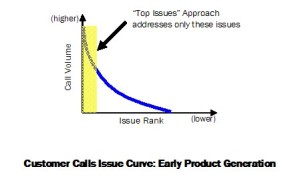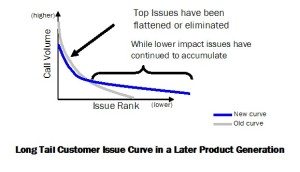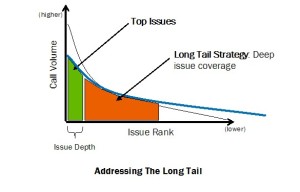I previously wrote about how the traditional shallow Pareto of customer support issues is no longer a useful approach to mitigate support calls.  The surprising news is that most companies have created this situation for themselves. There are two primary ways that companies do this.
The surprising news is that most companies have created this situation for themselves. There are two primary ways that companies do this.
1. Long term focus on top issues Pareto: When a company has a long term policy of addressing the top support issues, then over time the top issues get smaller, while the smaller issues increase in quantity. The few top issues are either eliminated – taking them off the Pareto entirely, or reduced, shifting them lower in the Pareto. Doing this again and again yields a situation in which the top issues are continuallyeliminated while very little happens with the small issues. These small issues then are responsible for the vast majority of calls.
2. Proliferation of products: A large company with diversified businesses, such as an consumer electronics company or computer manufacturer may have many product lines, w ith each product line having many products. With hundreds of products, each product itself having hundreds of issues, it is likely for the company to be faced with tens of thousands of issues. In many cases companies may needlessly worsen the situation. For example, derivative products created to ensure different SKUs for different channels may artificially inflate the number of customer issues because issues are tracked by product. In other cases, companies may release very minor updates to refresh product lines for seasonal events – these updates may each have their own issues. (Conversely, the frequent updates associated with agile development for web services do not create a proliferation of different products, because the “older” product is essentially retired with each update of the web site; there is only one product, and it is the most up to date, fresh one.)
ith each product line having many products. With hundreds of products, each product itself having hundreds of issues, it is likely for the company to be faced with tens of thousands of issues. In many cases companies may needlessly worsen the situation. For example, derivative products created to ensure different SKUs for different channels may artificially inflate the number of customer issues because issues are tracked by product. In other cases, companies may release very minor updates to refresh product lines for seasonal events – these updates may each have their own issues. (Conversely, the frequent updates associated with agile development for web services do not create a proliferation of different products, because the “older” product is essentially retired with each update of the web site; there is only one product, and it is the most up to date, fresh one.)
 rers have frequently asked questions on their websites, but I need the infrequently asked questions.” Companies need a customer support strategy that address the long tail. Not surprisingly, social media will have a substantial role to play, but that alone is not sufficient to address a long tail situation. In my next post on this topic, I’ll go into the three key forces identified by Chris Anderson in The Long Tail, and discuss how those forces apply to customer support.
rers have frequently asked questions on their websites, but I need the infrequently asked questions.” Companies need a customer support strategy that address the long tail. Not surprisingly, social media will have a substantial role to play, but that alone is not sufficient to address a long tail situation. In my next post on this topic, I’ll go into the three key forces identified by Chris Anderson in The Long Tail, and discuss how those forces apply to customer support.





